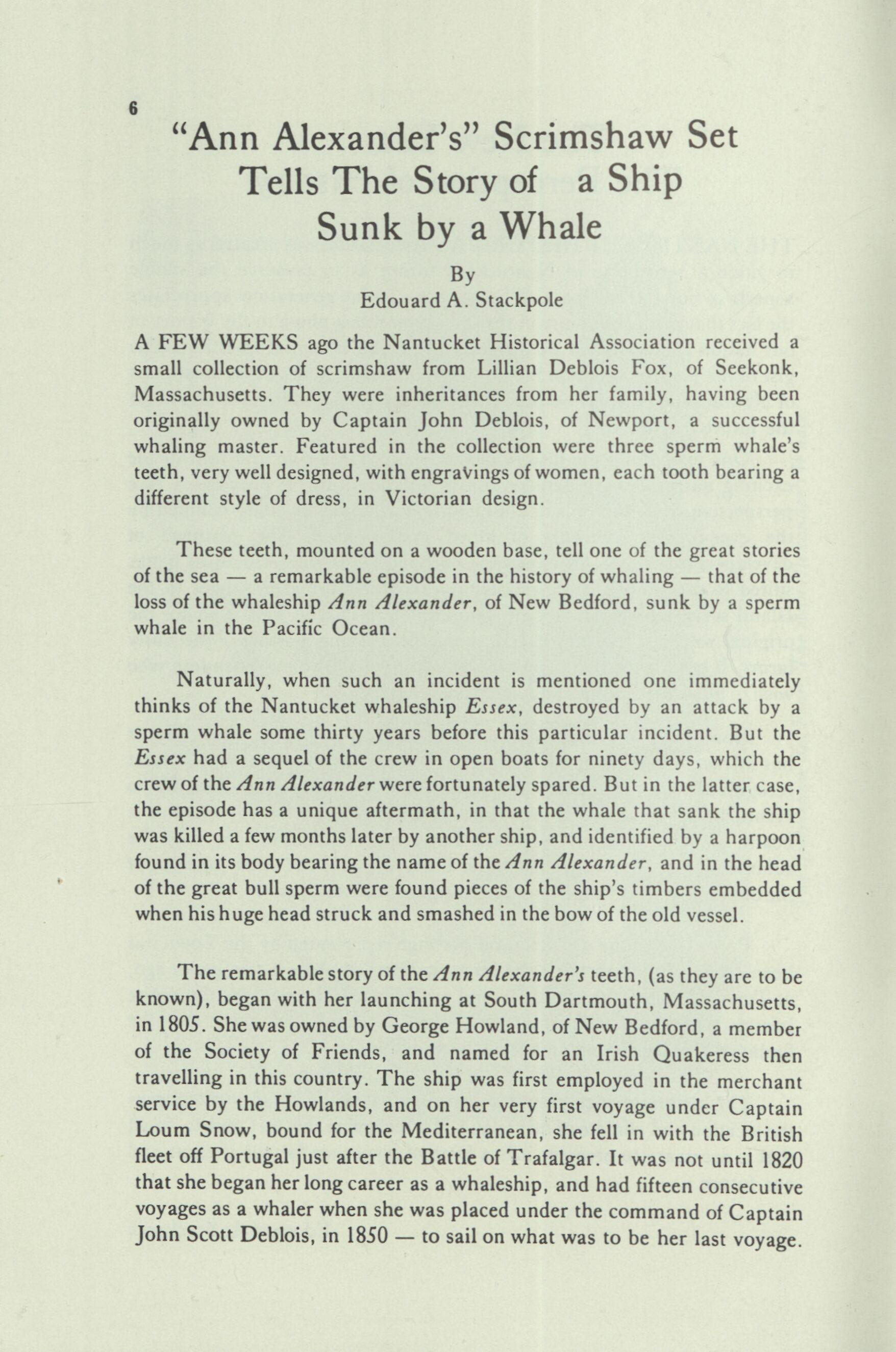
16 minute read
Ship Sunk by a Whale
6
"Ann Alexander's" Scrimshaw Set Tells The Story of a Ship Sunk by a Whale
B y Edouard A. Stackpole
A FEW WEEKS ago the Nantucket Historical Association received a small collection of scrimshaw from Lillian Deblois Fox, of Seekonk, Massachusetts. They were inheritances from her family, having been originally owned by Captain John Deblois, of Newport, a successful whaling master. Featured in the collection were three sperm whale's teeth, very well designed, with engravings of women, each tooth bearing a different style of dress, in Victorian design.
These teeth, mounted on a wooden base, tell one of the great stories of the sea — a remarkable episode in the history of whaling — that of the loss of the whaleship Ann Alexander, of New Bedford, sunk by a sperm whale in the Pacific Ocean.
Naturally, when such an incident is mentioned one immediately thinks of the Nantucket whaleship Essex, destroyed by an attack by a sperm whale some thirty years before this particular incident. But the Essex had a sequel of the crew in open boats for ninety days, which the crew of the Ann Alexander were fortunately spared. But in the latter case, the episode has a unique aftermath, in that the whale that sank the ship was killed a few months later by another ship, and identified by a harpoon found in its body bearing the name of the Ann Alexander, and in the head of the great bull sperm were found pieces of the ship's timbers embedded when his huge head struck and smashed in the bow of the old vessel.
The remarkable story of the Ann Alexander's teeth, (as they are to be known), began with her launching at South Dartmouth, Massachusetts, in 1805. She was owned by George Howland, of New Bedford, a member of the Society of Friends, and named for an Irish Quakeress then travelling in this country. The ship was first employed in the merchant service by the Howlands, and on her very first voyage under Captain Loum Snow, bound for the Mediterranean, she fell in with the British fleet off Portugal just after the Battle of Trafalgar. It was not until 1820 that she began her long career as a whaleship, and had fifteen consecutive voyages as a whaler when she was placed under the command of Captain John Scott Deblois, in 1850 — to sail on what was to be her last voyage.
THE "ANN ALEXANDER'S" SCRIMSHAW SET 7
A native of Newport, R. I., who had served as mate of the ship on the voyage preceding his assumption of command, Captain Deblois was a veteran whaleman. The Ann Alexander sailed from New Bedford on June 10, 1850, with fifteen men in the crew and bound for the Azores, where the balance of the crew was to be recruited. The logbook of this voyage was lost, no doubt when the ship sank, but the account of her adventures may be reconstructed from letters the captain wrote to his wife as the ship sailed, and from his own story printed in The Whaleman's Shipping List, of Nov. 4, 1851, and a later account.
While on the River Plate Ground in December, 1850, the ship's boats had an encounter with a fighting whale which was somewhat of a prelude to what was to come when they reached the Pacific. While rounding Cape Horn in March, 1851, a man was lost overboard during a gale. After getting some fresh provisions at Payta, Peru, the ship headed for the Galapagos Islands. In August they spoke the ship Rebecca Simms, Captain Jernegan, of New Bedford. This was a prophetic meeting, as it was the Simms' boats that actually killed the whale that sank the Ann Alexander.
On August 20, 1851, the ship was cruising — the day after they had "spoken" the Simms, — and at sundown a large whale was sighted from the mast-head. Boats were lowered but in the darkness the whale disappeared. Captain Deblois lay a course during the night along the range where he thought the whale might go, and on the next morning, at dawn, they sighted him again. Allowing the men to have their breakfast, he then lowered two boats, with the mate commanding one and he the other. As they approached the whale, Captain Deblois called to the mate, "This is a noble fellow. Don't galley him!"
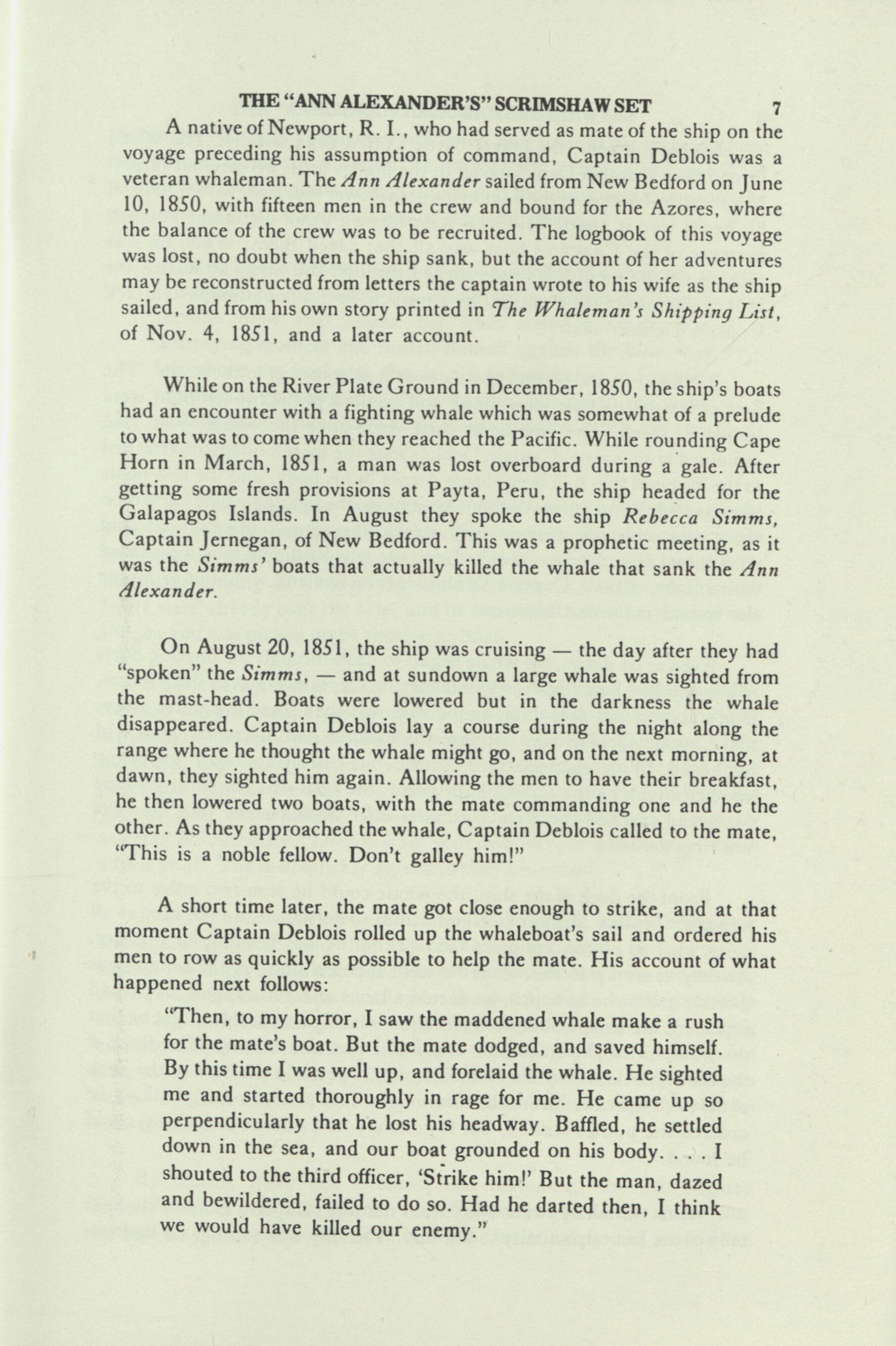
A short time later, the mate got close enough to strike, and at that moment Captain Deblois rolled up the whaleboat's sail and ordered his men to row as quickly as possible to help the mate. His account of what happened next follows:
"Then, to my horror, I saw the maddened whale make a rush for the mate's boat. But the mate dodged, and saved himself. By this time I was well up, and forelaid the whale. He sighted me and started thoroughly in rage for me. He came up so perpendicularly that he lost his headway. Baffled, he settled down in the sea, and our boat grounded on his body. ... I shouted to the third officer, 'Strike him!' But the man, dazed and bewildered, failed to do so. Had he darted then, I think we would have killed our enemy."
8 HISTORIC NANTUCKET
At that moment, the tide of battle shifted dramatically. The whale turned from Captain Deblois' boat to the mate's boat, his original target. In a surge he had taken the boat in his great lower jaw and, with a twist of his head, tore it apart. The men were thrown in all directions and the presence of the Captain's boat was all that saved them. While he was picking up the men, the whale rushed through the water attacking the broken sections of the boat, but by a miracle he did not attempt to attack Captain Deblois' craft.
By this time the second mate's boat had come up to the scene. The oars of the mate's boat were found and sections of the broken boat were lashed to them. The two boats then went after the whale, who had remained at the scene. Captain Deblois took the mate's line, still attached to the harpoon that had been thrust deeply in his body, and the two boats approached the creature. Without hesitation, the fighting whale turned on them and with one furious rush struck the second mate's boat and demolished it — the men knocked into the sea. Realizing they were faced with another attack, Captain Deblois cut the line and set about to rescue the second mate and his crew.
Even as he did so, the whale began to dash through the floating parts of the wrecked boats, narrowly missing the Captain's boat in the process. The situation was desperate, as the ship was then some five miles away, and Captain Deblois was not sure the lookout had discerned what had happened. With eighteen men in the one surviving boat, expecting another attack by the furious bull sperm, the boat was rowed at a smart pace, and reached the Ann Alexander after what seemed like hours of working the oars.
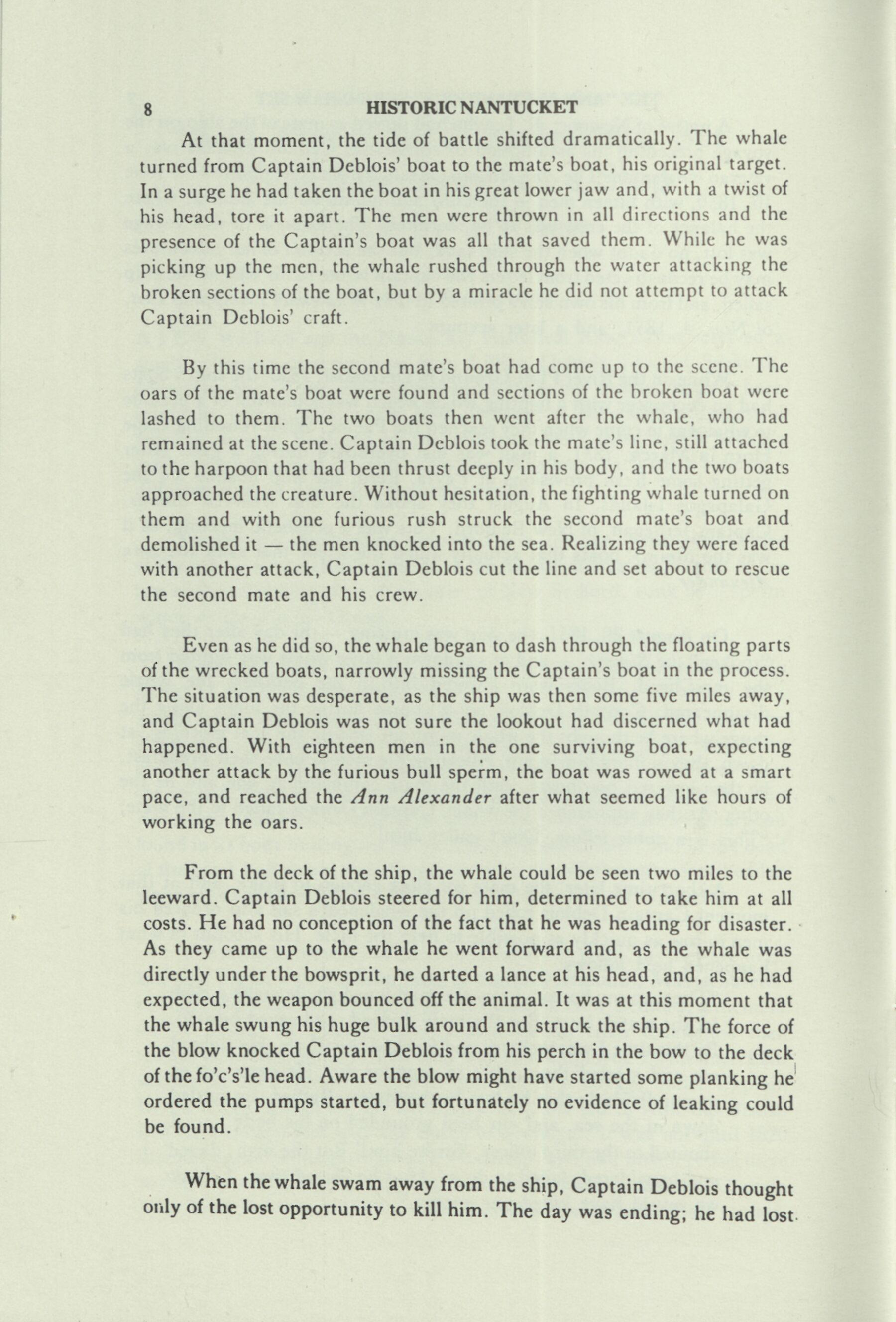
From the deck of the ship, the whale could be seen two miles to the leeward. Captain Deblois steered for him, determined to take him at all costs. He had no conception of the fact that he was heading for disaster. As they came up to the whale he went forward and, as the whale was directly under the bowsprit, he darted a lance at his head, and, as he had expected, the weapon bounced off the animal. It was at this moment that the whale swung his huge bulk around and struck the ship. The force of the blow knocked Captain Deblois from his perch in the bow to the deck of the fo'c's'le head. Aware the blow might have started some planking he ordered the pumps started, but fortunately no evidence of leaking could be found.
When the whale swam away from the ship, Captain Deblois thought only of the lost opportunity to kill him. The day was ending; he had lost
THE "ANN ALEXANDER'S" SCRIMSHAW SET 9
two boats, two lines, a harpoon and lance, and some of his men had been injured. Accepting the situation, he gave up the pursuit and ordered the mizzen and main topsails braced up, so that the ship could come into the wind and sail off. Captain Deblois' account follows:
"Just as I gave these orders, I caught a glimpse of a shadow, as it seemed to me, when the whale again struck the ship a terrible blow that shook her from stem to stern. The destroying monster had hurled himself against the bow, four feet above the keel and abreast the foreswifter. I at once attempted to go down into the forecastle, but heard the water rushing in at a rate that I knew it was hopeless. I felt the ship was gone."
The Ann Alexander was doomed. The water swept through the vessel so quickly that Captain Deblois, going down into the main cabin for some navigational instruments and supplies, was nearly trapped by the water surging aft through the ship. Back on deck he found that two boats were already over the side, and he was saved when he jumped into the sea and was picked up by the mate's boat.
The situation was perilous to an extreme. Night was falling rapidly; the ship was gradually sagging over on its side; the two boats had become separated. The only water was in the kegs in the boats, and some of the hardtack, kept in another keg, was the only food available. Besides these problems Captain Deblois was being questioned by his crew: "Why did you go after the whale?" "Where is the nearest land?" He promptly asserted his authority. "Do you want your own way, or do you want me to advise you?" The men quickly agreed to obey his orders.
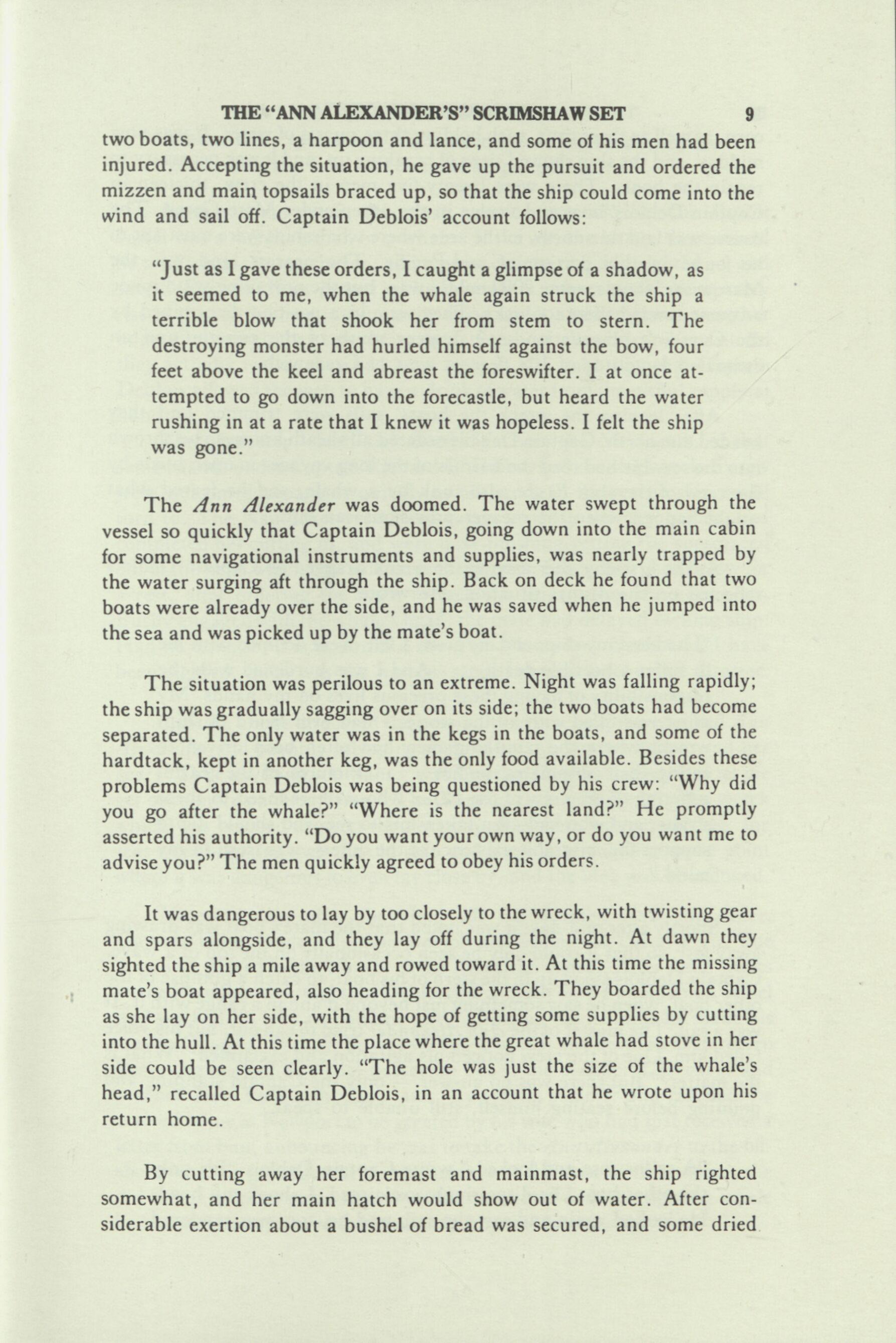
It was dangerous to lay by too closely to the wreck, with twisting gear and spars alongside, and they lay off during the night. At dawn they sighted the ship a mile away and rowed toward it. At this time the missing mate's boat appeared, also heading for the wreck. They boarded the ship as she lay on her side, with the hope of getting some supplies by cutting into the hull. At this time the place where the great whale had stove in her side could be seen clearly. "The hole was just the size of the whale's head," recalled Captain Deblois, in an account that he wrote upon his return home.
By cutting away her foremast and mainmast, the ship righted somewhat, and her main hatch would show out of water. After considerable exertion about a bushel of bread was secured, and some dried
10 HISTORIC NANTUCKET
corn, as well as three cans, each holding three quarts of water. It was now midday, and the ship showed signs of breaking up, and it was necessary to regain the boats. There were twenty-five men in the crew, thirteen in Captain Deblois' boat and twelve in the other under Mate Green. The course was laid due north, in the area where whaleships were most apt to be found in this portion of mid-Pacific. The nearest land was the Marquesas Islands, some 2000 miles away, but the prevailing wind made a course toward them too risky. They were in a position determined by the Captain's observation as 2 degrees south of the equator and an estimated longitude of 102 degrees west of Greenwich.
After leaving the wreck the boats' sails were trimmed and they headed due north. Captain Deblois ordered all sheath knives to be thrown into the sea. He had read the horrors of the long voyages in open boats by the crew of the ship Essex, also sunk by a whale, and he feared what would happen when the meager provisions ran out.
As the first day after leaving the wreck dragged on Captain Deblois reflected on the dismal situation. He wrote:
"I had lost my ship; and my crew, I felt, were doomed with me to suffer a horrible death. . . . And I was burdened with the responsibility of having these precious lives on my hands. My mind was filled with all the stories I had ever heard of shipwrecks where the famishing men had often been driven to eating their shipmates' bodies Pictures of the fearful suffering of the crew of the Essex who were reduced to these straits, and who had even taken lots to see who should die to support the miserable existence of the others, was fresh in my mind."

Shortly after mid-day, it was noted that the mate's boat was drawing away fast, so that it could only be seen occasionally on the top of a wave. Captain Deblois stood up in the stern of his boat, to catch a glimpse of the other boat, when he saw something just beyond it and in a range with it. It was a sail. The master of the Ann Alexander tried to call out, but his voice failed him. One of the crew noticed his agitation and exclaimed: "What is the matter?" But there was no answer — only the Captain standing and pointing before seating himself, still unable to speak.
"A sailor rose and looked," wrote Captain Deblois. 'It's only the other boat,' he dispairingly exclaimed. I shook my head. He looked again and saw the sail, and he, too, was rendered
THE "ANN ALEXANDER'S" SCRIMSHAW SET 11
momentarily speechless. Then the men rose and confirmed the good news, and I did all I could to keep them quiet."
As they came nearer the great question was whether the distant vessel was a merchantman or a whaler. If she was the latter, there would be a watch at the mastheads, and a great chance of being sighted — and saved! The next hour passed with all hands at a fever pitch. With every rise in the sea the men involuntarily stood up for another glance, another hope. Only when they saw their companion boat ahead drop her sail did they actually realize they had been seen. It was only then that Captain Deblois allowed the men to have a drink of water from the pitiful supply at hand.
The whaleship which had saved them was the Nantucket, of that same island, under Captain Richard C. Gibbs, and the shipwrecked crew were welcomed aboard as quickly as all hands in the rescue ship could turn to. The Nantucket vessel had taken a whale the day before, had completed her cutting in, and were busy finishing getting the spermaceti out of the head which was still on deck. Captain Gibbs had gone below for a rest, after ordering the mate to tack the ship during the next hour. Busily engaged with the whale's head, the mate had delayed tacking ship. Had he done so, it is doubtful if the Ann Alexander's boats would have been sighted. Such was the narrow range between rescue and disaster.
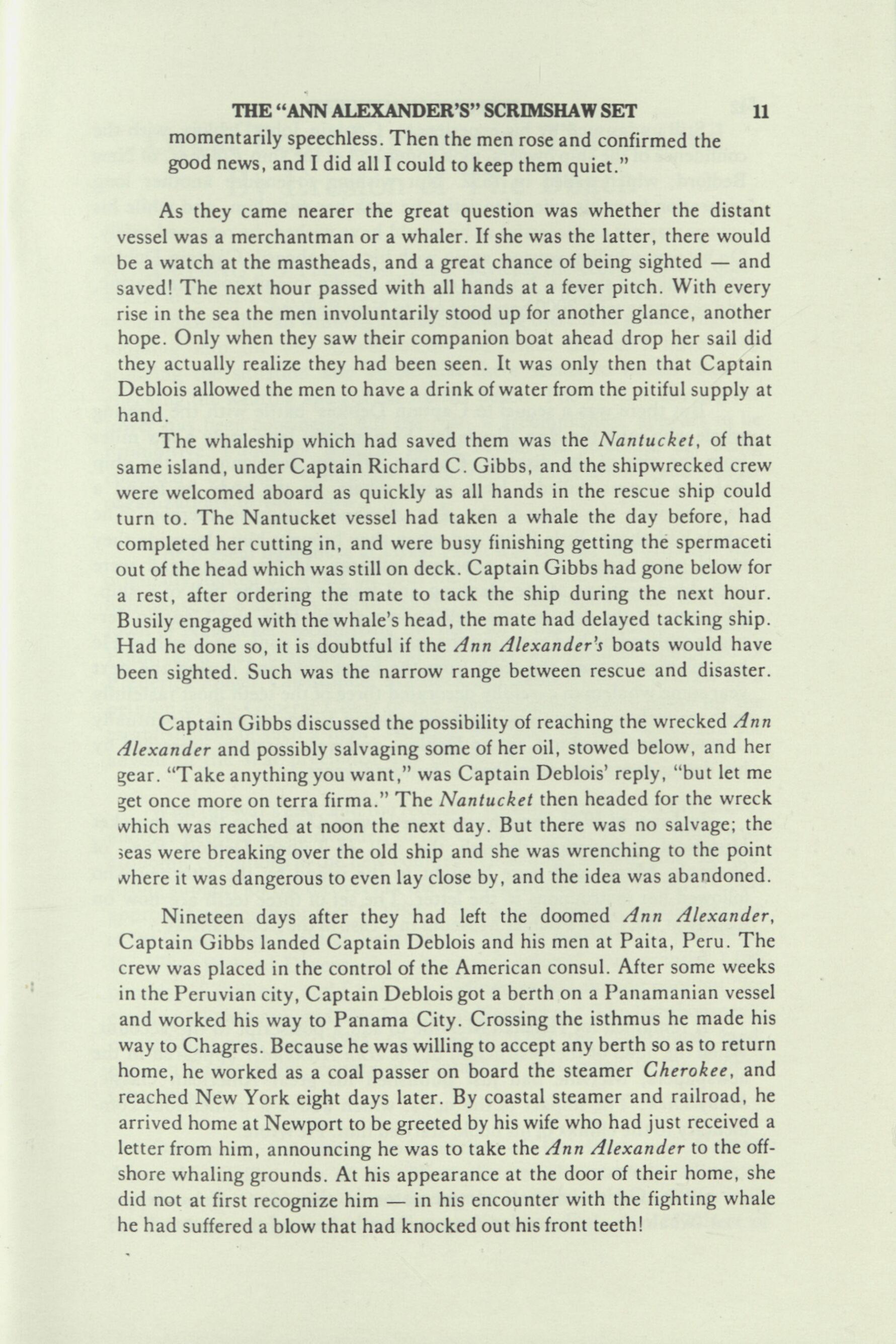
Captain Gibbs discussed the possibility of reaching the wrecked Ann Alexander and possibly salvaging some of her oil, stowed below, and her gear. "Take anything you want," was Captain Deblois' reply, "but let me get once more on terra firma." The Nantucket then headed for the wreck which was reached at noon the next day. But there was no salvage; the seas were breaking over the old ship and she was wrenching to the point where it was dangerous to even lay close by, and the idea was abandoned.
Nineteen days after they had left the doomed Ann Alexander, Captain Gibbs landed Captain Deblois and his men at Paita, Peru. The crew was placed in the control of the American consul. After some weeks in the Peruvian city, Captain Deblois got a berth on a Panamanian vessel and worked his way to Panama City. Crossing the isthmus he made his way to Chagres. Because he was willing to accept any berth so as to return home, he worked as a coal passer on board the steamer Cherokee, and reached New York eight days later. By coastal steamer and railroad, he arrived home at Newport to be greeted by his wife who had just received a letter from him, announcing he was to take the Ann Alexander to the offshore whaling grounds. At his appearance at the door of their home, she did not at first recognize him — in his encounter with the fighting whale he had suffered a blow that had knocked out his front teeth!
12 HISTORIC NANTUCKET
Still undaunted by his experiences, Captain John Deblois, with the confidence of the ship owners, took command of the ship Vigilant, of New Bedford, which sailed in 1852. Not wishing to endure another long separation from his wife, Henrietta, he took her with him, and while his voyage was not as successful as he would have wished, he returned safely. On his next whaling voyage, again with his wife aboard, Captain Deblois at last enjoyed success, bringing the ship Merlin to and from the Pacific, and returning with 2000 barrels of oil, to New Bedford.
But there was a sequel to Captain Deblois' battle with the fighting whale who sank the Ann Alexander. Five months later, only a few miles from the site of the disaster, Captain William Jernegan, in the ship Rebecca Simms, killed a large sperm whale. In the body he found a harpoon with the name of the Ann Alexander stamped thereon. The whale had shown little fight, and when they brought him alongside they found good reason for his apparent lethargy. In his huge head were embedded portions of the planking and frames from the hull of a ship. The story of the disaster was well known at this time and Captain Jernegan realized he had captured the whale who had sunk a whaleship. He had his men remove the teeth from the lower jaw, and during the next year some whaleman carefully decorated three of the teeth most tastefully with scrimshaw — detailing the three ladies in Victorian garb. Eventually they were presented to Captain Deblois, and were carefully preserved by his descendants for more than a hundred years.
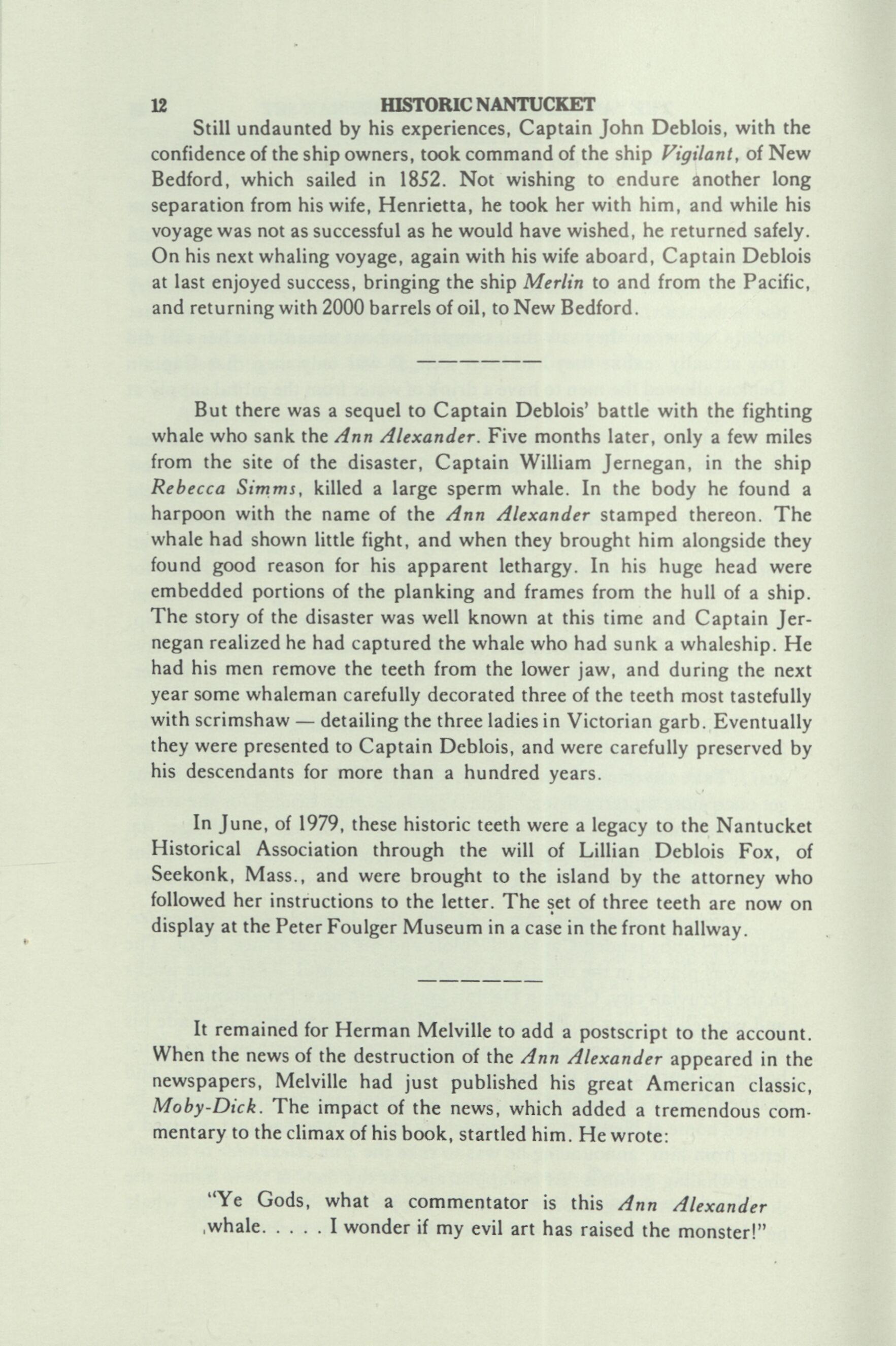
In June, of 1979, these historic teeth were a legacy to the Nantucket Historical Association through the will of Lillian Deblois Fox, of Seekonk, Mass., and were brought to the island by the attorney who followed her instructions to the letter. The set of three teeth are now on display at the Peter Foulger Museum in a case in the front hallway.
It remained for Herman Melville to add a postscript to the account. When the news of the destruction of the Ann Alexander appeared in the newspapers, Melville had just published his great American classic, Moby-Dick. The impact of the news, which added a tremendous commentary to the climax of his book, startled him. He wrote:
"Ye Gods, what a commentator is this Ann Alexander whale I wonder if my evil art has raised the monster!"







